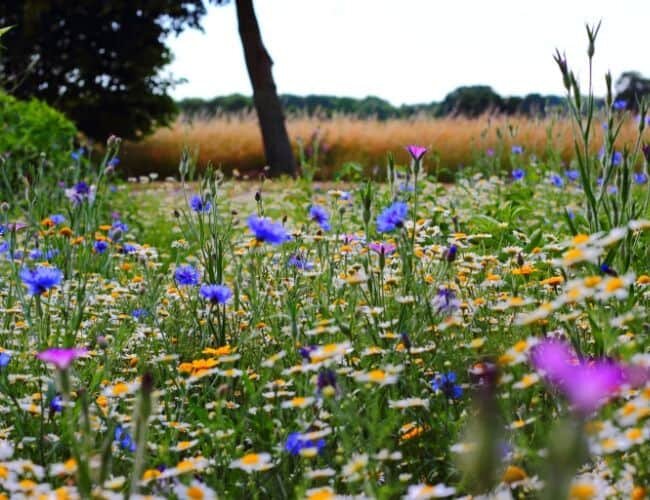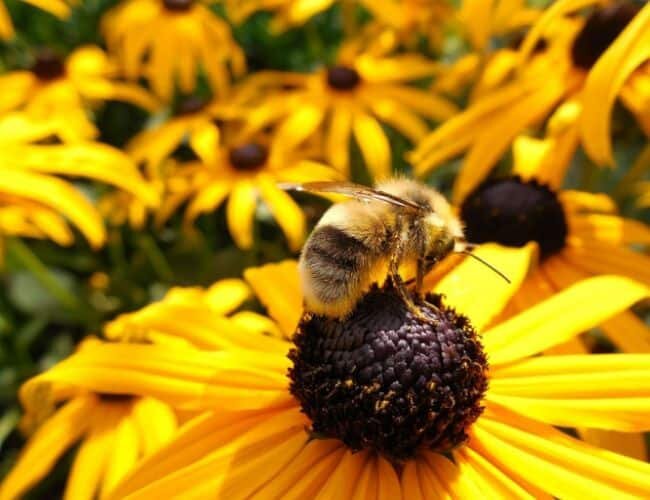Building a Backyard Wildlife Sanctuary
Have you ever thought about getting your home garden certified as a wildlife sanctuary?
It’s quite likely you already have many of the things you need to be certified, and a few minor tweaks will allow you to get an official certification from the National Wildlife Federation.
Why Would I Want a National Wildlife Federation Certification?
Well, because it’s cool, of course!

Seriously, though, meeting the requirements for certification means you’re giving wildlife (including beneficial insects) the best environment to grow and raise healthy young. You’ll also reap the benefits in better, healthier crops and bigger flowers from pollination, and the fun of watching the birds and wildlife right in your own backyard.
This is a great activity to teach your kids respect for the natural world as well, and they’ll enjoy participating in the process. As a bonus, that’s lots of healthy outdoor time (which leads to tired kids in the evening, easier bedtimes….you get the idea!) Homeschoolers, I imagine, could use this in their curriculums, as well.
How Hard is it to Get the Certification & How Much Does it Cost?
There are 5 different categories you need to meet for certification, which I’ll get into in more detail below.
The cost is just $20, which entitles you to a year’s membership in the National Wildlife Federation, including their magazine and discounts in their online store.
You also have the option of purchasing a sign (for an additional fee) to place in your yard stating that you’re a certified wildlife habitat. I think this is a wonderful idea, because it may give your neighbors and those driving by the idea that they should do this too, and more healthy gardens are a very good thing!
In fact, at one point, my little town of Colchester, CT was certified as a community wildlife habitat! If you’d like to check out their Facebook page, you can do that here.
Let’s get started with each of the categories….
This post contains affiliate links. When you make a purchase through one of these links, I receive a small commission. This does not affect your purchase price.
Category 1: Food for Wildlife
You’ll need at least three food sources for wildlife. This isn’t as hard as it sounds, however.
You can, of course, add feeders to your yard in the form of bird or suet feeders, hummingbird feeders and squirrel feeders.
If you DON’T want to feed the squirrels from your bird feeder, you need a squirrel-proof feeder (trust me on this!) I have variations on all four below, and they work well.

And yes, I do have 4 feeders up! I have A LOT of birds in my yard. Even with the 4 feeders, this time of year, I fill every day.
By the way, it’s a myth that you don’t need to feed birds in the summer. This is when they’re raising their young and need all the help they can get. I feed year-round.
Trust me, get a squirrel-proof suet feeder too, or you’ll be buying A LOT of suet! Woodpeckers love suet, and other birds feed it to their babies as a good protein source, so you’ll go through enough of it without feeding the squirrels too. (Tractor Supply has great deals on multi-packs of suet and black oil sunflower seed, be sure to check them out!)
TIP: In my experience, putting squirrel baffles on the feeders doesn’t work, they WILL find a way around, over or through them. Trust me, just spend the few extra dollars on a squirrel-proof feeder, you’ll be happy you did!
PRO TIP: I only feed black oil sunflower seed in my 3 regular feeders (and suet cakes, of course, in the suet feeder). Although you’ll be led to believe that goldfinches need nyjer seed and other birds need this and that, they all LOVE black oil sunflower seed. It’s a bit more expensive than some of the wild bird seed mixes, but a lot of seed mixes are full of varieties the birds don’t really like that much. Believe me, they WILL root through the feeders looking for the stuff they like!
Of course, if you have flowering or fruiting plants, these also count as food sources for wildlife, so if bird feeding isn’t your thing, you have other options as well. Even foliage and twigs are considered food sources, and I’m pretty sure all but the most citified habitat is going to have those!
Category 2: Water
This one’s easy! You only need one water source, and it can be as simple as a birdbath or as elaborate as a backyard pond or water garden. Even a butterfly puddling area counts as a water source!
I love the bird bath below because birds are attracted to running water, and you won’t have to worry about mosquito larvae growing in the water either.
Category 3: Cover
Birds and other wildlife need protection to roost and raise their young. If you live in a wooded area, you’ve got one of the two requirements already taken care of in the form of a wooded area.
A bramble patch is also good cover for many small animals. Why not grow some raspberries? This will give you a delicious crop while also helping wildlife. We have wild blackberry bushes at the edge of the woods as well, and you may too.

and you’ll a get yummy harvest for yourself!
Do you have a rock wall or wood pile in your yard? Yup, that’s cover too! How about that huge pile we all have of brush and leaves we clean out of our yards? Yup, bunnies, mice, birds, they all LOVE those piles!
Maybe you live where there aren’t many woods and you have to let the town take your brush each year. You can still install roosting boxes as one of the cover requirements. There are SOOOOO many options for roosting boxes, I didn’t want to link to just one. You can go here and look at a large variety. You’re sure to find one that’ll fit your unique situation.
Do you have any evergreens in or around your yard? That counts too! Even ground covers like thyme and clover can act as a refuge for small insects.
Category 4: Places to Raise Young
If you have several of the options in category 3, you’re already covered for this one. You need two of the options in this category.

Mature trees and shrubs or thickets are great places for many different critters to raise their young.
You can also grow host plants like milkweed and dill for caterpillars. I get both monarchs and swallowtails by growing these lovely plants in my yard.
Lastly, of course, you can put up nesting boxes for birds as well. These can be a bit different from roosting boxes, and are specific to the variety of bird you’re trying to attract as the entrance holes vary in size.
Just go ahead and google whatever bird it is you’re looking to attract or help, and you’ll get lots of ideas. For instance, if you’d like to attract or help bluebirds, this site gives you lots of information. Maybe you’d prefer to attract Carolina wrens. Here you go!
Making your own nesting boxes can be a really fun activity for parents and older kids, and what a thrill when a bird family moves in to the nesting boxes you built yourself! (Of course, you can buy prebuilt ones as well, if you prefer).
Category 5: Sustainable Practices
This one is new since the last time I checked on certification. Personally, I think it’s AWESOME that they’ve finally included this.
There are 3 aspects to this category, but it’s still not complex. You’ll want to have at least one facet of each category covered.
Soil & Water Conservation
This one’s easy! Catch rainwater from your roof in a rain barrel. Use drip or soaker hose irrigation (Hey! I’ve written about that, have you seen it yet?) Mulch your garden (you do mulch your garden, right?)

you can see the rainwater diverter running from the downspout
Look how easy that one was!
NOTE: Some municipalities put limits and regulations on rainwater collection. Please check with your town before collecting rainwater.
Control Exotic Species
The easiest ways to complete this particular category are to plant native plants and reduce your lawn area.
Why not make part of your lawn a wildflower meadow? Dig up some lawn and plant butterfly weed or milkweed. Even replacing grass with clover is beneficial for a number of the insect good guys, particularly bees.

Check out this link to find the best native plants for birds and other beneficials in your area.
Organic Practices
Hopefully, you’re already doing this. It simply involves NOT using chemical pesticides or fertilizers. You can also compost to complete this category.
Have you ever tried worm composting? No? You can check out my posts on worm composting here and here, if you’d like to give it a try.
In addition to worm composting, I also have an outdoor tumbling composter. I did have an open pile, but just didn’t seem to have enough composting materials to make it work well. Below is a composter similar to the one I have. It’s so easy to just add the materials and give it a spin or two every week!
How to Get Certified

So, have I convinced you getting certified is a good idea? If so, you can go here to get certified. You can also scroll down on the above page to “get checklist” that lists all the categories and what you can do to get certified in a PDF.
I hope today’s post has inspired you. Even if you don’t want to pursue certification, I trust I’ve given you some fun ideas for things you can do to support wildlife in your own backyard.
You’ll find pinnable images below. If you’ve found this post helpful, please pin to your Organic Gardening or Beneficials or even Backyard Birds board for future reference.
As always, smile and have a crazy organic day!
Posts Related to Create a Backyard Wildlife Sanctuary
- Subscribers Resource Library
- Worms, worms, worms!
- Worm composting
- Grow Organic Raspberries
- How Not to Water your Garden
- Shrubs to Attract Beneficials
- Sustainable Garden
- No-Till Gardening
- How (and why!) to Attract Dragonflies to your Garden




8 comments
Well I certainly qualify. Birds are so attracted to my back porch I had a cardinal land on my leg! Scared the bejesus out of both of us! 70% of my county is national forest so I am not sure I need my back yard certified, but if I didn’t live just past the middle of nowhere I would definitely do it.
Hahahaha, just past the middle of nowhere, huh? Sounds like a great place to live actually. I might just join you!
Too cool! I didn’t even know you could do this! Is it available worldwide?
I’m actually not sure. I’ll send the NWF a quick message and let you know when I find out.
I always think about getting certified but have never followed through. I do love having wildlife in my garden. And that meadow and a shallow pond would just make it perfect.
🙂 gwingal
I know, right? I need those too! One of these days….
I never knew that. Very informative.. Personally love the wildflowers. We planted some this year. I told hubby I would love to do away with a lot of lawn and plant more..
Always a good idea to plant more wildflowers!